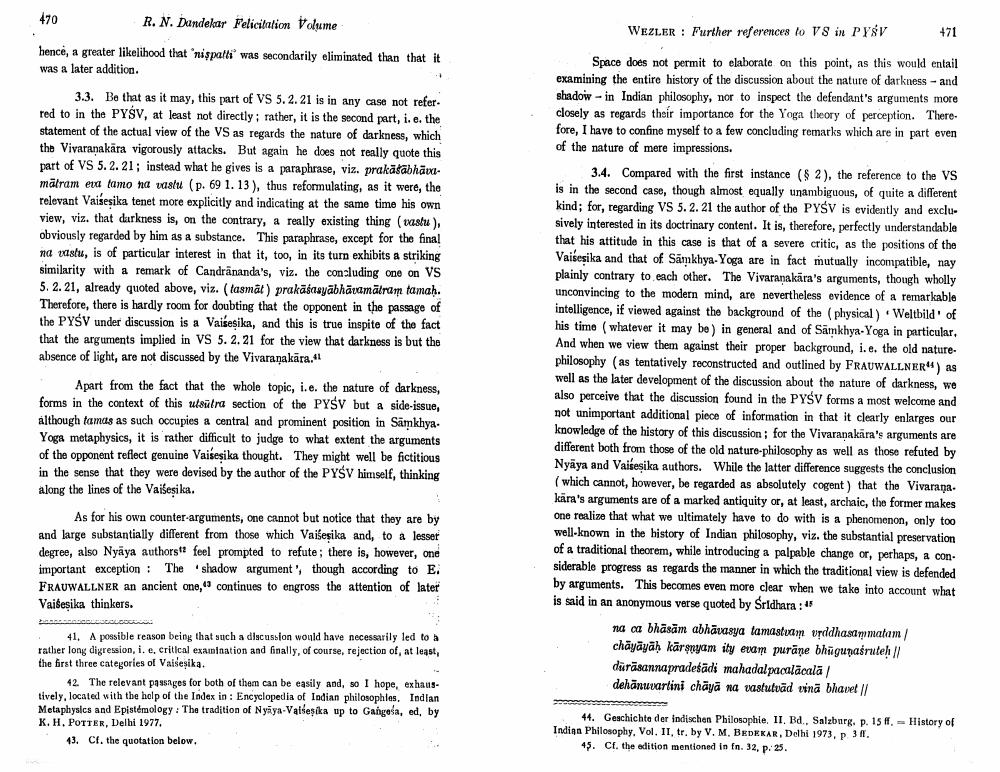Book Title: Further References To Vaisesika Sutra In Patanjala Yogasastra Vivarana Author(s): A Wezler Publisher: A Wezler View full book textPage 8
________________ 470 R. N. Dandekar Felicitation Volume WEZLER : Further references to VS in PYSV 471 hence, a greater likelihood that nispalti was secondarily eliminated than that it was a later addition. 3.3. Be that as it may, this part of VS 5.2.21 is in any case not referred to in the PYSV, at least not directly, rather, it is the second part, i.e. the statement of the actual view of the VS as regards the nature of darkness, which the Vivaranakära vigorously attacks. But again he does not really quote this part of VS 5. 2. 21; instead what he gives is a paraphrase, viz. prakadabhauxmālram e tamo na rasi (p. 69 1. 13), thus reformulating, as it were, the relevant Vaiseșika tenet more explicitly and indicating at the same time his own view, vix, that darkness is, on the contrary, a really existing thing (vastu), obviously regarded by him as a substance. This paraphrase, except for the final na rastu, is of particular interest in that it, too, in its turn exhibits a striking similarity with a remark of Candrananda's, viz. the concluding one on VS 5. 2. 21, already quoted above, viz. ( tasmal) prakāśasyābhāramālrum tamah. Therefore, there is hardly room for doubting that the opponent in the passage of the PYSV under discussion is a Vai esika, and this is true inspite of the fact that the arguments implied in VS 5. 2.21 for the view that darkness is but the absence of light, are not discussed by the Vivaranakara.41 Space does not permit to elaborate on this point, as this would entail examining the entire history of the discussion about the nature of darkness - and shadow - in Indian philosophy, nor to inspect the defendant's arguments more closely as regards their importance for the Yoga theory of perception. There fore, I have to confine myself to a few concluding remarks which are in part even of the nature of mere impressions. 3.4. Compared with the first instance ($ 2), the reference to the VS is in the second case, though almost equally unambiguous, of quite a different kind; for, regarding VS 5.2.21 the author of the PYSV is evidently and exclusively interested in its doctrinary content. It is, therefore, perfectly understandable that his attitude in this case is that of a severe critic, as the positions of the Vaisesika and that of Samkhya-Yoga are in fact mutually incompatible, nay plainly contrary to each other. The Vivaranakāra's arguments, though wholly unconvincing to the modern mind, are nevertheless evidence of a remarkable intelligence, if viewed against the background of the physical) Weltbild of his time ( whatever it may be) in general and of Samkhya-Yoga in particular, And when we view them against their proper background, i.e. the old nature philosophy (as tentatively reconstructed and outlined by FRAUWALLNER") as well as the later development of the discussion about the nature of darkness, we ceive that the discussion found in the PYSV forms a most welcome and not unimportant additional piece of information in that it clearly enlarges our knowledge of the history of this discussion; for the Vivaranakara's arguments are different both from those of the old nature-philosophy as well as those refuted by Nyaya and Vaiseșika authors. While the latter difference suggests the conclusion (which cannot, however, be regarded as absolutely cogent that the Vivarana. kara's arguments are of a marked antiquity or, at least, archaic, the former makes one realize that what we ultimately have to do with is a phenomenon, only too well-known in the history of Indian philosophy, viz. the substantial preservation of a traditional theorem, while introducing a palpable change or perhaps, a con. siderable progress as regards the manner in which the traditional view is defended by arguments. This becomes even more clear when we take into account what is said in an anonymous verse quoted by Sridhara :" Apart from the fact that the whole topic, i.e. the nature of darkness, forms in the context of this utsülre section of the PYSV but a side-issue, although tamas as such occupies a central and prominent position in Samkhya. Yoga metaphysics, it is rather difficult to judge to what extent the arguments of the opponent reflect genuine Vaisesika thought. They might well be fictitious in the sense that they were devised by the author of the PYSV himself, thinking along the lines of the Vaišeşi ka. As for his own counter arguments, one cannot but notice that they are by and large substantially different from those which Vaiseșika and, to a lesser degree, also Nyaya authors feel prompted to refute; there is, however, one important exception: The shadow argument though according to E. FRAUWALLNER an ancient one, continues to engross the attention of later Vaišesika thinkers. na a bhāsām abhāvasya tamastatin Urddhasim malam/ chäyāyāḥ kārenyam ity exam puräne bhūgunaśruteh // darasannapradešāds mahadalpicalacala / dehānuvartini chāyā na vastutuäd ina bhavet | 41. A possible reason being that such a discussion would have necessarily led to a rather long digression, i. e, critical examination and finally, of course, rejection of, at least, the first three categories of Valsesika. 42. The relevant passages for both of them can be easily and, so I hope, exhaus tively, located with the help of the Index in: Encyclopedia of Indian philosophies. Indian Metaphysics and Epistemology: The tradition of Nyāya-Valsesika up to Galgosa, ed. by K. H. POTTER, Delhi 1977. 13. Cf. the quotation below. 44. Geschichte der indischen Philosophie. II. Bd, Salzburg, p. 15 ff - History of Indian Philosophy, Vol. II, tr. by V. M. BEDEKAR, Delhi 1973, p 3, 45. Cf. the edition mentioned in in. 32, p. 25.Page Navigation
1 ... 6 7 8 9
